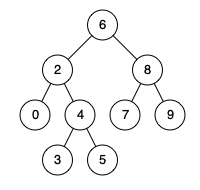Lowest Common Ancestor of a Binary Search Tree
Problem
Given a binary search tree (BST), find the lowest common ancestor (LCA) node of two given nodes in the BST.
According to the definition of LCA on Wikipedia: “The lowest common ancestor is defined between two nodes
pandqas the lowest node inTthat has bothpandqas descendants (where we allow a node to be a descendant of itself).”
Example 1:
Input: root = [6,2,8,0,4,7,9,null,null,3,5], p = 2, q = 8 Output: 6 Explanation: The LCA of nodes 2 and 8 is 6.Example 2:
Input: root = [6,2,8,0,4,7,9,null,null,3,5], p = 2, q = 4 Output: 2 Explanation: The LCA of nodes 2 and 4 is 2, since a node can be a descendant of itself according to the LCA definition.Example 3:
Input: root = [2,1], p = 2, q = 1 Output: 2
Pseudocode
Solution
Time and Space Complexity
Time
Finding values in a binary search tree is dependent on tree height O(height)
Total - O(h)
Space
space required by recursive function for finding a value in BST is also O(h) - it doesn't scale linearly with input size
Total - O(h)
Last updated
